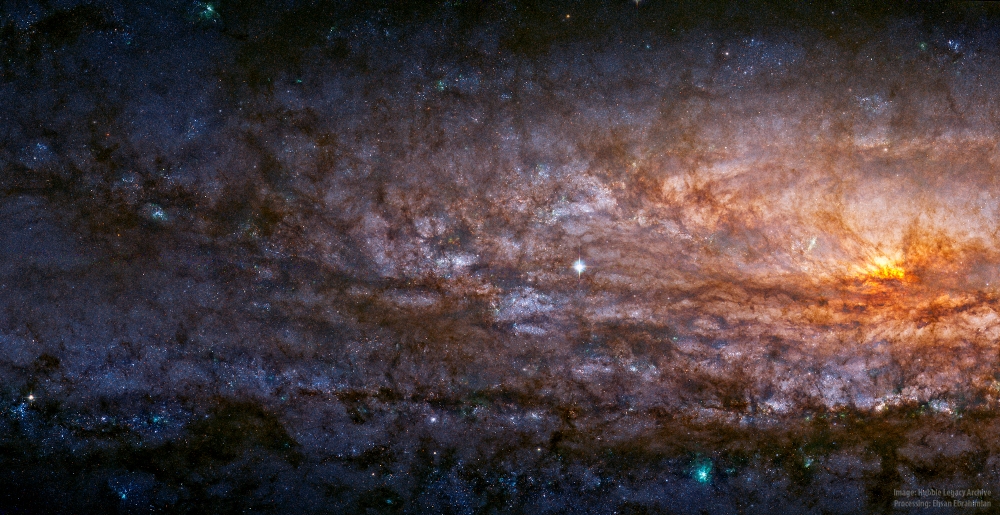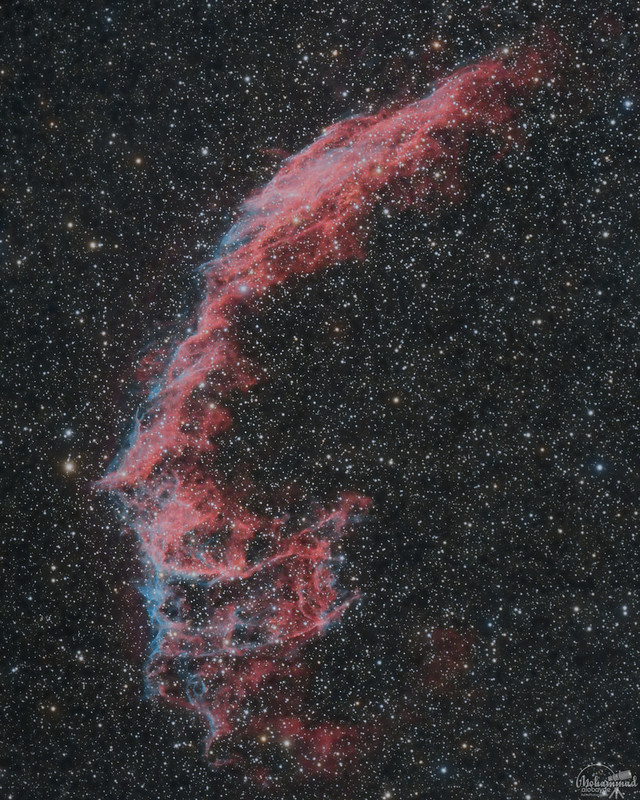Submissions: 2021 November
-
RoiLevi
Re: Submissions: 2021 November
The Observer
https://deepspaceworkshops.com/
Copyright: Roi Levi
Man Vs The universe shot with canon 6da sky stacked and tracked in pixinsight 6 frames iso 800 180 sec each sub
foreground blue hour iso 100 F18 1/500 all images from same tripod position
https://cdn.astrobin.com/images/38116/2 ... e2fa85.jpg
https://deepspaceworkshops.com/
Copyright: Roi Levi
Man Vs The universe shot with canon 6da sky stacked and tracked in pixinsight 6 frames iso 800 180 sec each sub
foreground blue hour iso 100 F18 1/500 all images from same tripod position
https://cdn.astrobin.com/images/38116/2 ... e2fa85.jpg
Last edited by bystander on Thu Nov 11, 2021 1:49 pm, edited 1 time in total.
Reason: Please, no hot links to images > 500 kb.
Reason: Please, no hot links to images > 500 kb.
-
sendhilchinnasamy
- Ensign
- Posts: 17
- Joined: Fri Sep 17, 2021 7:31 pm
Re: Submissions: 2021 November
The Spaghetti Nebula
Catalogued as Sharpless 2-240, this faint supernova remnant goes by the popular nickname, the Spaghetti Nebula. It is fairly large (150 light years across) and located 3000 light years away toward the boundary of the constellations Taurus and Auriga. Light from the massive stellar explosion first reached Earth 40,000 years ago.
The violent stellar explosion that created the Spaghetti Nebula left behind all that remains of the original star’s core: a spinning neutron star known as pulsar PSR J0538+2817, surrounded by intricate filaments of material. This expanding remnant has an expansion rate of about 950 kilometers (nearly 600 miles) per second.
Total integration: 41h 45'
Location: Georgetown, Texas

Catalogued as Sharpless 2-240, this faint supernova remnant goes by the popular nickname, the Spaghetti Nebula. It is fairly large (150 light years across) and located 3000 light years away toward the boundary of the constellations Taurus and Auriga. Light from the massive stellar explosion first reached Earth 40,000 years ago.
The violent stellar explosion that created the Spaghetti Nebula left behind all that remains of the original star’s core: a spinning neutron star known as pulsar PSR J0538+2817, surrounded by intricate filaments of material. This expanding remnant has an expansion rate of about 950 kilometers (nearly 600 miles) per second.
Total integration: 41h 45'
Location: Georgetown, Texas

Re: Submissions: 2021 November
Sh2-132, Lion Nebula
https://www.mauricetoet.nl/DeepSky/i-N6z8GsB/A
Copyright: Maurice Toet Exposure time: 16 hours, 10 minutes (141x 300" Hα, 53x 300" OIII) | Optics: Takahashi ε-180ED f/2.8 | Camera: ZWO ASI294MM Pro (B 2x2, G 120, T -15 °C) | Acquisition: ZWO ASIair Pro | Filters: Baader-Planetarium Ultra-Highspeed | Mount: Astro-Physics Mach1 GTO | Location: Zoetermeer, Netherlands | Date: 27 & 28 October and 8 November 2021
https://www.mauricetoet.nl/DeepSky/i-N6z8GsB/A
Copyright: Maurice Toet Exposure time: 16 hours, 10 minutes (141x 300" Hα, 53x 300" OIII) | Optics: Takahashi ε-180ED f/2.8 | Camera: ZWO ASI294MM Pro (B 2x2, G 120, T -15 °C) | Acquisition: ZWO ASIair Pro | Filters: Baader-Planetarium Ultra-Highspeed | Mount: Astro-Physics Mach1 GTO | Location: Zoetermeer, Netherlands | Date: 27 & 28 October and 8 November 2021
-
tommasostella
- Ensign
- Posts: 60
- Joined: Mon Nov 11, 2019 4:34 pm
Re: Submissions: 2021 November
The Flaming Star nebula (IC 405)
Author: Tommaso Stella
total exposure: 9,3h
The image is the result of shooting with OSC camera.
Acquiring took place in TARANTO-Italy 10m a.s.l.
Technical data
Lights: 112x300s @ 250 Gain (-15°C), 51 Dark, 84 Flat
Telescope: TS PhotoLine Apochromatic FPL53 Triplet 102 @ f/5.53
Camera: ZWO ASI 294mc Pro
Mount: Skywatcher AZ-EQ6 GT
Autoguide: ASI 224mc & Ultraguide 60
Filters: Optolong L-Enhance
Processing: DeepSkyStacker, Photoshop CC, PixInsight, AstraImage Plus
Author: Tommaso Stella
total exposure: 9,3h
The image is the result of shooting with OSC camera.
Acquiring took place in TARANTO-Italy 10m a.s.l.
Technical data
Lights: 112x300s @ 250 Gain (-15°C), 51 Dark, 84 Flat
Telescope: TS PhotoLine Apochromatic FPL53 Triplet 102 @ f/5.53
Camera: ZWO ASI 294mc Pro
Mount: Skywatcher AZ-EQ6 GT
Autoguide: ASI 224mc & Ultraguide 60
Filters: Optolong L-Enhance
Processing: DeepSkyStacker, Photoshop CC, PixInsight, AstraImage Plus
Re: Submissions: 2021 November
This is my first post here 
I recently processed the Hubble Legacy Archive data of NGC 253; it is a two-panel mosaic, and here is the resized version:
You can find the full size of it (about 40MB) here:
https://drive.google.com/file/d/1qp8fsu ... sp=sharing
read more about this image:
https://www.instagram.com/p/CVfPR6WtDxM/
Your comments are welcome
I recently processed the Hubble Legacy Archive data of NGC 253; it is a two-panel mosaic, and here is the resized version:
You can find the full size of it (about 40MB) here:
https://drive.google.com/file/d/1qp8fsu ... sp=sharing
read more about this image:
https://www.instagram.com/p/CVfPR6WtDxM/
Your comments are welcome
-
Nicolas Adriano
- Ensign
- Posts: 20
- Joined: Wed Oct 07, 2020 5:06 pm
Re: Submissions: 2021 November
Abell 1060 - The Hydra Cluster
Copyright: Nicolas Adriano
Image URL: https://cdn.astrobin.com/images/67318/2 ... af7c3c.jpg
The largest spiral galaxy in the Hydra Cluster is NGC3312, which is located 194 million light years from Earth, and spans itself for 171,000 light years. To give you some perspective of how big and how far this galaxy is:
Photographing such a big object located that far away, is the same as photographing a 2 meter tall person 2 kilometers away. Or, the same as photographing a 10 centimeter pen 113 meters away.
Acquired by CHI-1 telescope system from Telescope Live
Telescope: Planewave CDK24
Camera: FLI ProLine PL9000
Filters: Astrodon LRGB 2GEN
Mount: Mathis MI-1000/1250 with absolute encoders
Location: El Sauce Observatory - Río Hurtado, Coquimbo Region, Chile
L: 2x600s
R: 10x300s and 2x600s
G: 10x300s and 1x600s
B: 10x300s and 2x600s
Total Integration Time: 220' or 3hrs40min.
Copyright: Nicolas Adriano
Image URL: https://cdn.astrobin.com/images/67318/2 ... af7c3c.jpg
The largest spiral galaxy in the Hydra Cluster is NGC3312, which is located 194 million light years from Earth, and spans itself for 171,000 light years. To give you some perspective of how big and how far this galaxy is:
Photographing such a big object located that far away, is the same as photographing a 2 meter tall person 2 kilometers away. Or, the same as photographing a 10 centimeter pen 113 meters away.
Acquired by CHI-1 telescope system from Telescope Live
Telescope: Planewave CDK24
Camera: FLI ProLine PL9000
Filters: Astrodon LRGB 2GEN
Mount: Mathis MI-1000/1250 with absolute encoders
Location: El Sauce Observatory - Río Hurtado, Coquimbo Region, Chile
L: 2x600s
R: 10x300s and 2x600s
G: 10x300s and 1x600s
B: 10x300s and 2x600s
Total Integration Time: 220' or 3hrs40min.
Re: Submissions: 2021 November
Hello and welcome to Starship Asterisk*!ehsaneb wrote: ↑Thu Nov 11, 2021 8:00 pm This is my first post here
I recently processed the Hubble Legacy Archive data of NGC 253; it is a two-panel mosaic, and here is the resized version:
You can find the full size of it (about 40MB) here:
https://drive.google.com/file/d/1qp8fsu ... sp=sharing
read more about this image:
https://www.instagram.com/p/CVfPR6WtDxM/
Your comments are welcome
1) Is that an open or a globular cluster?
2) Is that a globular cluster?
3) Wow, that seems to be a large widespread open cluster (or association) that seems to have formed from outflows of gas from the center of NGC 253! Amazing!
4) That's a nice nebula!
Ann
Color Commentator
-
Daniel Feller
Re: Submissions: 2021 November
IC 342 - The Hidden Galaxy of Camelopardalis
https://chaoticnebula.com
Copyright: Daniel Feller A beautiful galaxy that doesn’t get much recognition. IC 342 lies very close to the Milky Way, between 7 million and 11 million light years away. However, from Earth’s perspective, we have to peer through the dusty area of the galactic equator to see IC 342, which can obscure the visibility. This is why the galaxy is sometimes referred to as The Hidden Galaxy. However, even with the line of site through the galactic equator, IC 342 stands out. IC 342 does not belong to the local group of galaxies. Instead, it leads the IC 342 group, which is the closest group to our Local Group.
Image Details: 60*600 seconds Red, 60*600 seconds Green, 60*600 seconds Blue, and 30*600 seconds through HA Filter (35 hours total).
Dates Taken: Over 11 nights through Sept/Oct 2021
Location: Suburbs of Minneapolis
Telescope: Meade 12” LX200
Mount: Losmandy G11T
Camera: ZWO ASI 1600MM
https://chaoticnebula.com
Copyright: Daniel Feller A beautiful galaxy that doesn’t get much recognition. IC 342 lies very close to the Milky Way, between 7 million and 11 million light years away. However, from Earth’s perspective, we have to peer through the dusty area of the galactic equator to see IC 342, which can obscure the visibility. This is why the galaxy is sometimes referred to as The Hidden Galaxy. However, even with the line of site through the galactic equator, IC 342 stands out. IC 342 does not belong to the local group of galaxies. Instead, it leads the IC 342 group, which is the closest group to our Local Group.
Image Details: 60*600 seconds Red, 60*600 seconds Green, 60*600 seconds Blue, and 30*600 seconds through HA Filter (35 hours total).
Dates Taken: Over 11 nights through Sept/Oct 2021
Location: Suburbs of Minneapolis
Telescope: Meade 12” LX200
Mount: Losmandy G11T
Camera: ZWO ASI 1600MM
Re: Submissions: 2021 November
ThanksAnn wrote: ↑Fri Nov 12, 2021 9:28 am
Hello and welcome to Starship Asterisk*!That's a fine picture!

NGC 253 annotated Ehsan Ebrahimian.png
1) Is that an open or a globular cluster?
2) Is that a globular cluster?
3) Wow, that seems to be a large widespread open cluster (or association) that seems to have formed from outflows of gas from the center of NGC 253! Amazing!
4) That's a nice nebula!
Ann
here is a larger size of that region:

I think the both 1&2 are globular clusters. Open clusters are all around, which is consistent with the starburst nature of this galaxy.
-
Meiying Lee
- Ensign
- Posts: 66
- Joined: Sun Aug 15, 2021 8:28 am
Re: Submissions: 2021 November
An omega moonset’s continuous change
The inferior mirage of celestial bodies rising or falling from the sea level is the most special and beautiful mirage. This is a special phenomenon that occurs when there is a low-density layer of hot air on the surface of the earth or ocean due to refraction. The most common one is the sun’s inferior mirage. The moon’s inferior mirage is not common because it is dark, but if you have the opportunity to see the moon’s inferior mirage, you can just use the terrain and potholes on the moon to confirm the mirage with inverted shape!
The weather was good on November 10th, and I was lucky enough to meet the rare inferior mirage of the sinking moon! When the moon is very close to the sea level, the inverted virtual image below will form and slowly rise and connect with the upright image above to form a rare sight like an Etruscan vase or Omega (Ω) shape !
This combined picture includes the appearance of the lower mirage, the rising, and the connection with the upright image above, like an Etruscan vase. Then the bottleneck of the vase becomes thicker and shorter, and finally only a corner disappears on the sea surface.
Link to the time-lapse video where the mirage appears under the moon and is connected to the upright image: https://youtu.be/49HA67u_f20
The inferior mirage of celestial bodies rising or falling from the sea level is the most special and beautiful mirage. This is a special phenomenon that occurs when there is a low-density layer of hot air on the surface of the earth or ocean due to refraction. The most common one is the sun’s inferior mirage. The moon’s inferior mirage is not common because it is dark, but if you have the opportunity to see the moon’s inferior mirage, you can just use the terrain and potholes on the moon to confirm the mirage with inverted shape!
The weather was good on November 10th, and I was lucky enough to meet the rare inferior mirage of the sinking moon! When the moon is very close to the sea level, the inverted virtual image below will form and slowly rise and connect with the upright image above to form a rare sight like an Etruscan vase or Omega (Ω) shape !
This combined picture includes the appearance of the lower mirage, the rising, and the connection with the upright image above, like an Etruscan vase. Then the bottleneck of the vase becomes thicker and shorter, and finally only a corner disappears on the sea surface.
Link to the time-lapse video where the mirage appears under the moon and is connected to the upright image: https://youtu.be/49HA67u_f20
-
spiantino
Re: Submissions: 2021 November
Melotte 15 in the Heart Nebula
Taken over 9 hours of exposure on 11/8 and 11/9 with an 11" SCT in Pine Plains, NY
Full size image (20MB): https://www.dropbox.com/s/geg1cpubim34n ... .jpeg?dl=0
Copyright: Serkan Piantino (sp at spiantino.net)
Taken over 9 hours of exposure on 11/8 and 11/9 with an 11" SCT in Pine Plains, NY
Full size image (20MB): https://www.dropbox.com/s/geg1cpubim34n ... .jpeg?dl=0
Copyright: Serkan Piantino (sp at spiantino.net)
Re: Submissions: 2021 November
SH2-184 (NGC 281, Pacman Nebula) and IC 1590
SH2-184 (also known as NGC 281 or Pacman Nebula) is an emission nebula in constellation Cassiopeia containing many Bok globules and the very young star cluster IC 1590.
Click on the images for detailed information and full resolution pictures.
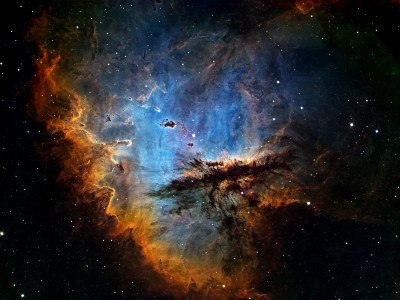
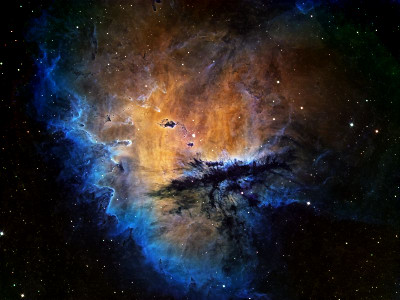
---
My Homepage
RSS news feed
SH2-184 (also known as NGC 281 or Pacman Nebula) is an emission nebula in constellation Cassiopeia containing many Bok globules and the very young star cluster IC 1590.
Click on the images for detailed information and full resolution pictures.


---
My Homepage
RSS news feed
- the_astronomy_enthusiast
- Ensign
- Posts: 98
- Joined: Fri Apr 16, 2021 10:16 pm
- Contact:
Re: Submissions: 2021 November

Hubble's view of M82 by William Ostling, on Flickr
A full write-up with processing steps can be found here: "https://theastroenthusiast.com/hubbles- ... messier-82
Also known as the Cigar Galaxy because of its appearance, Messier 82 is a starburst galaxy with a superwind. In fact, through supernova explosions and powerful winds from massive stars, the burst of star formation is driving the stunning red outflows. This image highlights emission from filaments of atomic hydrogen gas in reddish hues. The filaments extend for well over 10,000 light-years.
I would highly recommend viewing this image on gigapan, where you can zoom in to the full resolution. http://www.gigapan.com/gigapans/227686
Website: https://theastroenthusiast.com/
Instagram: https://www.instagram.com/the_astronomy_enthusiast/
Re: Submissions: 2021 November
M51 in H-alpha and continuum light
M51 (also known as Whirlpool Galaxy) are two interacting galaxies in constellation Canes Venatici. The larger one (M51A or NGC 5194) is a spiral galaxy, the smaller companion (M51B or NGC 5195) is a distorted a dwarf galaxy.
The image is calculated with and without H-alpha information. By toggling between the two variants the correlation between HII gas clouds and bluish regions (containing young stars and probably also OIII gas) can be visualized.
Click on the animation for detailed information and full resolution pictures.
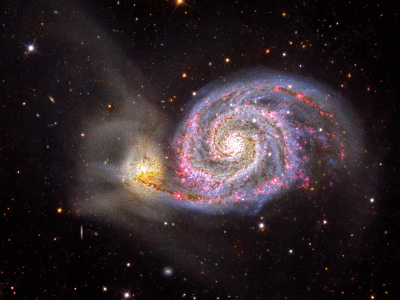
---
My Homepage
RSS news feed
M51 (also known as Whirlpool Galaxy) are two interacting galaxies in constellation Canes Venatici. The larger one (M51A or NGC 5194) is a spiral galaxy, the smaller companion (M51B or NGC 5195) is a distorted a dwarf galaxy.
The image is calculated with and without H-alpha information. By toggling between the two variants the correlation between HII gas clouds and bluish regions (containing young stars and probably also OIII gas) can be visualized.
Click on the animation for detailed information and full resolution pictures.

---
My Homepage
RSS news feed
-
blastrophoto
- Ensign
- Posts: 11
- Joined: Sun Nov 14, 2021 9:54 pm
Re: Submissions: 2021 November
IC410 - The Tadpole Nebula
Seen above is IC410 in the SHO color palette. IC 410 is a faint and dusty emission nebula of more than 100 light-years across approximately 12,000 light-years away from Earth in the northern constellation of Auriga. Notable are two streamers of material, known as the “Tadpoles of IC 410”. These tadpoles, which consist of denser, cooler gas and dust, are approximately 10 light-years long and potentially sites of ongoing star formation. They are almost in the center of the image.
Gear Used for Capture:
Telescope - Explore Scientific ED127 FCD100
Camera - ZWO ASI2600MM Pro
Filters - Astronomik SII, HA, OIII 12nm 2"
Mount - Skywatcher EQ6-R Pro
Field Flattener - Hotec 2" SCA Field Flattener
Processing performed in Pixinsight, Photoshop, and Topaz Denoise
Integration:
SII - 51x300s
HA - 56x 300s
OIII - 55x300s
Captured at Cherry Springs State Park, PA on November 7th 2021
Seen above is IC410 in the SHO color palette. IC 410 is a faint and dusty emission nebula of more than 100 light-years across approximately 12,000 light-years away from Earth in the northern constellation of Auriga. Notable are two streamers of material, known as the “Tadpoles of IC 410”. These tadpoles, which consist of denser, cooler gas and dust, are approximately 10 light-years long and potentially sites of ongoing star formation. They are almost in the center of the image.
Gear Used for Capture:
Telescope - Explore Scientific ED127 FCD100
Camera - ZWO ASI2600MM Pro
Filters - Astronomik SII, HA, OIII 12nm 2"
Mount - Skywatcher EQ6-R Pro
Field Flattener - Hotec 2" SCA Field Flattener
Processing performed in Pixinsight, Photoshop, and Topaz Denoise
Integration:
SII - 51x300s
HA - 56x 300s
OIII - 55x300s
Captured at Cherry Springs State Park, PA on November 7th 2021
Re: Submissions: 2021 November
Luglio 2021/Ottobre 2021
Località: San Romualdo - Ravenna
Sky Bortle 5
Tecnosky AG 70/350 - CCD QSI 583ws raffreddato -15
Avalon M1 - Celestron OAG - QHY5III 174M
Filtri RGB Astrodon Gen2 E-series e Narrowband 3nm
HA-RGB: HA 30x15min, R 30x5min, G 30x5min, B 30x5min.
Acquisizione: MaximDL5 - Calibrata con Dark, Bias e Flat
Elaborazione: MaximDL5, Astroart8, Paint Shop Pro2021, plug-in Topaz e Nik
Cristina Cellini
Località: San Romualdo - Ravenna
Sky Bortle 5
Tecnosky AG 70/350 - CCD QSI 583ws raffreddato -15
Avalon M1 - Celestron OAG - QHY5III 174M
Filtri RGB Astrodon Gen2 E-series e Narrowband 3nm
HA-RGB: HA 30x15min, R 30x5min, G 30x5min, B 30x5min.
Acquisizione: MaximDL5 - Calibrata con Dark, Bias e Flat
Elaborazione: MaximDL5, Astroart8, Paint Shop Pro2021, plug-in Topaz e Nik
Cristina Cellini
-
Chris_Linz
- Asternaut
- Posts: 1
- Joined: Mon Nov 15, 2021 9:33 am
Re: Submissions: 2021 November
Omicron Persei Star Forming Region
https://www.flickr.com/photos/147135308@N08/51679752596
Copyright: Christian Koll
Competing with nearby deep sky attractions like the California Nebula or the Pleiades star cluster, the region around Omicron Persei unfortunately does not get the attention it truly deserves. Only a deep exposure reveals the vast amounts of dust and gas that are in the process of gravitational collapse, forming new stellar objects. While many protostars are still hidden within their dusty enclosure, a young star cluster - IC 348 - has already emerged. Also standing out from the background of reddish hydrogen gas is Barnard 3, a prominent dark nebula discovered by Edward Barnard in the early 20th century.
Stack of 110 exposures at f/5.5 totalling approximately 8 hours.
Taken during 4 nights in Sptember, October and November 2021 in rural Upper Austria with a QHY600C-PH and a Skywatcher Espirt 100 at 550mm focal length. Tracking with Skywatcher EQ6-R, autoguiding with MGEN-3. Processed with Astro Pixel Proxessor, Starnet++ and Photoshop.
Best regards!
Chris Koll, Austria
https://www.flickr.com/photos/147135308@N08/51679752596
Copyright: Christian Koll
Competing with nearby deep sky attractions like the California Nebula or the Pleiades star cluster, the region around Omicron Persei unfortunately does not get the attention it truly deserves. Only a deep exposure reveals the vast amounts of dust and gas that are in the process of gravitational collapse, forming new stellar objects. While many protostars are still hidden within their dusty enclosure, a young star cluster - IC 348 - has already emerged. Also standing out from the background of reddish hydrogen gas is Barnard 3, a prominent dark nebula discovered by Edward Barnard in the early 20th century.
Stack of 110 exposures at f/5.5 totalling approximately 8 hours.
Taken during 4 nights in Sptember, October and November 2021 in rural Upper Austria with a QHY600C-PH and a Skywatcher Espirt 100 at 550mm focal length. Tracking with Skywatcher EQ6-R, autoguiding with MGEN-3. Processed with Astro Pixel Proxessor, Starnet++ and Photoshop.
Best regards!
Chris Koll, Austria
-
tommasostella
- Ensign
- Posts: 60
- Joined: Mon Nov 11, 2019 4:34 pm
Re: Submissions: 2021 November
The Cave Nebula
Copyright: Tommaso Massimo Stella
Url: https://www.facebook.com/tommaso.m.stella
Total exposure: 10h
Shots taken on 2 and 7 September 2021 in Taranto-Italy 10m a.s.l.
Technical data
Lights: 120x300s
Telescope: TS PhotoLine FPL53 Triplet 102 @ f/5.5
Camera: QHY 168C @ -15°C
Mount: Skywatcher AZ-EQ6 GT
Filters: Optolong L-Pro
Processing: DeepSkyStacker, Photoshop CC, PixInsight
Copyright: Tommaso Massimo Stella
Url: https://www.facebook.com/tommaso.m.stella
Total exposure: 10h
Shots taken on 2 and 7 September 2021 in Taranto-Italy 10m a.s.l.
Technical data
Lights: 120x300s
Telescope: TS PhotoLine FPL53 Triplet 102 @ f/5.5
Camera: QHY 168C @ -15°C
Mount: Skywatcher AZ-EQ6 GT
Filters: Optolong L-Pro
Processing: DeepSkyStacker, Photoshop CC, PixInsight
Re: Submissions: 2021 November
Abell 84, a wonderful planetary nebula in Cassiopeia.
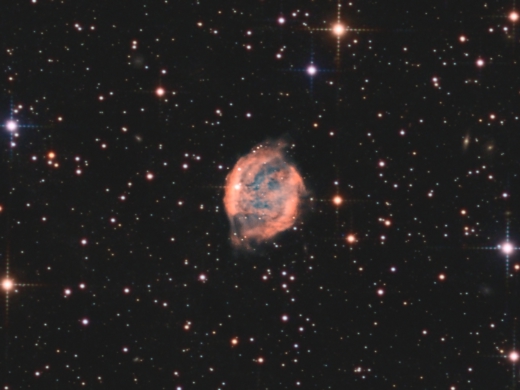
High-resolution image and technical data: http://www.javierlaina.es/IMAGENES/Abell84.html
Javier Gómez Laina (Spain)
http://www.javierlaina.es/indexeng.html

High-resolution image and technical data: http://www.javierlaina.es/IMAGENES/Abell84.html
Javier Gómez Laina (Spain)
http://www.javierlaina.es/indexeng.html
Re: Submissions: 2021 November
M27 Mixing long exposures and lucky imaging
This image of M27 is a mix of long and short exposures in order to bring out the faint extension of the nebula as well as the fine details of M27's core.
Halpha and OIII long exposures with Newton 10" and ASI2600mm : 224 x 300s
Halpha and OIII long exposures with RC16" and ASI2600mm : 200x300s
RGB long exposures with Newton 10" and ASI2600mm : 90x120s
Halpha lucky imaging with Newton 12"and Playerone Neptune color II : 5000x2.5s
IR - RVB lucky imaging with Newton 12"and Playerone Neptune color II : 40000x500ms

Full and information here: https://www.astrobin.com/d7tm46/0/
Mathieu Guinot
Stephane Gonzalez
Sébastien Kuenlin
This image of M27 is a mix of long and short exposures in order to bring out the faint extension of the nebula as well as the fine details of M27's core.
Halpha and OIII long exposures with Newton 10" and ASI2600mm : 224 x 300s
Halpha and OIII long exposures with RC16" and ASI2600mm : 200x300s
RGB long exposures with Newton 10" and ASI2600mm : 90x120s
Halpha lucky imaging with Newton 12"and Playerone Neptune color II : 5000x2.5s
IR - RVB lucky imaging with Newton 12"and Playerone Neptune color II : 40000x500ms

Full and information here: https://www.astrobin.com/d7tm46/0/
Mathieu Guinot
Stephane Gonzalez
Sébastien Kuenlin
-
parkesburg_observatory
- Asternaut
- Posts: 5
- Joined: Thu Apr 22, 2021 3:35 pm
Re: Submissions: 2021 November
Flaming Star Nebula up close in SHO
I took this from my B5 backyard over the last couple nights, and really loved the detail that came out. Shot with a Celestron Edge HD11 at 1960mm at f7.
Full res here: https://www.astrobin.com/3ynsgn/
Instagram: https://www.instagram.com/parkesburg_observatory/
Credit: Steven Gill (Parkesburg Observatory)
I took this from my B5 backyard over the last couple nights, and really loved the detail that came out. Shot with a Celestron Edge HD11 at 1960mm at f7.
Full res here: https://www.astrobin.com/3ynsgn/
Instagram: https://www.instagram.com/parkesburg_observatory/
Credit: Steven Gill (Parkesburg Observatory)
-
Nicolas Adriano
- Ensign
- Posts: 20
- Joined: Wed Oct 07, 2020 5:06 pm
Re: Submissions: 2021 November
NGC6960 - The Filamentary Nebula
Copyright: Nicolas Adriano
Image URL: https://cdn.astrobin.com/images/67318/2 ... c7547b.png
Acquired by Pier 7 telescope system from RoboScopes
Telescope: William Optics FLT132 F5.6 APO
Camera: ZWO ASI1600MM Pro
Filters: ZWO RGB HaOIII 7nm
Mount: Paramount MX
Location: e-Eye Observatory, Extremadura, South West Spain
Ha: 12x600"
OIII: 46x600"
R: 24x600"
G: 24x600"
B: 24x600"
Total Integration Time: 21hrs40min or 1300'
Copyright: Nicolas Adriano
Image URL: https://cdn.astrobin.com/images/67318/2 ... c7547b.png
Acquired by Pier 7 telescope system from RoboScopes
Telescope: William Optics FLT132 F5.6 APO
Camera: ZWO ASI1600MM Pro
Filters: ZWO RGB HaOIII 7nm
Mount: Paramount MX
Location: e-Eye Observatory, Extremadura, South West Spain
Ha: 12x600"
OIII: 46x600"
R: 24x600"
G: 24x600"
B: 24x600"
Total Integration Time: 21hrs40min or 1300'
-
blastrophoto
- Ensign
- Posts: 11
- Joined: Sun Nov 14, 2021 9:54 pm
Re: Submissions: 2021 November
M78
https://live.staticflickr.com/65535/516 ... bbf6_k.jpg
This colorful image features a wide field view of M78, a reflection nebula located in the constellation Orion. A reflection nebula is created when light from a star is scattered or reflected off a nearby dust cloud. M78 is located approximately 1,600 light-years away from Earth and has an apparent magnitude of 8.
Gear:
Orion ED80 at f4.8 390mm FL
Qhyccd 294M-Pro 1x1bin
Optolong LRGB 2" filters
Orion Sirius EQ-G Rowen Belt Modified Mount
Integration:
L - 42x300s
R - 29x300s
G - 30x300s
B - 30x300s
Processed in Photoshop and Pixinsight
https://live.staticflickr.com/65535/516 ... bbf6_k.jpg
This colorful image features a wide field view of M78, a reflection nebula located in the constellation Orion. A reflection nebula is created when light from a star is scattered or reflected off a nearby dust cloud. M78 is located approximately 1,600 light-years away from Earth and has an apparent magnitude of 8.
Gear:
Orion ED80 at f4.8 390mm FL
Qhyccd 294M-Pro 1x1bin
Optolong LRGB 2" filters
Orion Sirius EQ-G Rowen Belt Modified Mount
Integration:
L - 42x300s
R - 29x300s
G - 30x300s
B - 30x300s
Processed in Photoshop and Pixinsight
Last edited by bystander on Wed Nov 17, 2021 3:08 am, edited 1 time in total.
Reason: Please, no hot links to images > 500 kb.
Reason: Please, no hot links to images > 500 kb.
-
PatrickWinkler
- Ensign
- Posts: 82
- Joined: Wed May 25, 2016 4:24 pm
- Location: Traiskirchen (Austria)
- Contact:

